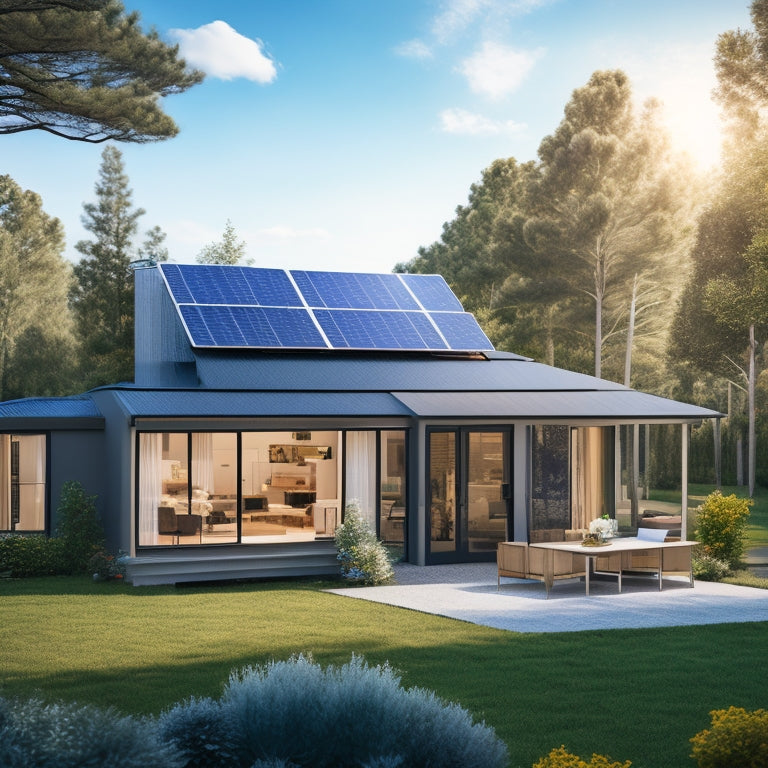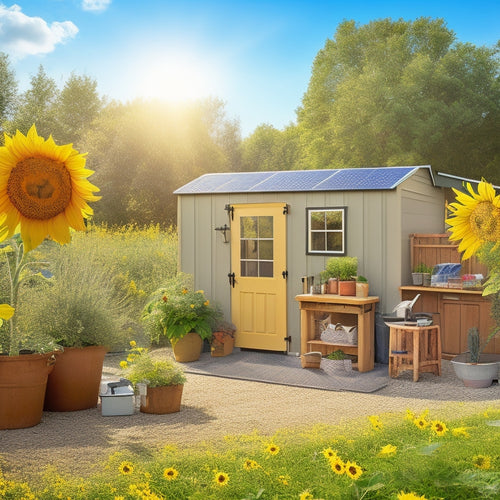
7 Tips for Home Energy Independence Kits
Share
You're on the path to energy independence with a home energy kit, but to maximize its potential, you'll want to assess your energy needs, choosing the right solar panels and battery-inverter combo for your unique situation. Optimize your energy storage by understanding your consumption patterns and implementing load management. Regular maintenance is key, so be prepared to clean and inspect your solar panels. Integrate your kit with your existing system, ensuring grid compatibility, and monitor your energy performance to identify areas for improvement. By following these steps, you'll be well on your way to cutting your energy bills - and there's even more to investigate to get the most out of your investment.
Key Takeaways
- Assess household energy consumption patterns to identify peak hours and areas for improvement in energy system design.
- Choose high-efficiency solar panels with durable warranties, considering temperature coefficient and type (monocrystalline, polycrystalline, or thin-film).
- Select a compatible battery and inverter combo, ensuring the inverter's continuous power rating matches home energy requirements.
- Optimize energy storage by determining ideal battery size, implementing load management, and reducing strain on the energy storage system.
- Regularly monitor system performance metrics, tracking energy production and consumption patterns to identify areas for improvement and optimize energy independence.
Assessing Your Energy Needs
As you begin your expedition towards home energy independence, understanding your energy needs is essential to determining the right solutions for your household.
You need to assess your energy consumption patterns, which are largely influenced by your lifestyle habits. Take note of the number of occupants, their daily routines, and the electrical appliances they use.
Identify the peak hours of energy usage, typically during mornings and evenings when lights, refrigerators, and HVAC systems are in operation. To get an accurate depiction of your energy needs, consider conducting an energy audit to track energy usage patterns and identify inefficiencies.
This will help you pinpoint areas for improvement and optimize your energy system design. Calculate your total energy consumption in kilowatt-hours (kWh) per month to determine the required capacity of your energy independence kit.
Choosing the Right Solar Panels
When selecting solar panels for your home energy independence kit, you'll want to evaluate panel efficiency, as it directly impacts the amount of energy generated per hour of sunlight.
Look for panels with efficiency ratings above 20% for maximum energy generation per sunlight hour high efficiency ratings.
You should also assess the durability and warranties offered by different manufacturers, as these factors will influence the panels' performance and lifespan.
Review warranty options, aiming for coverage of performance, materials, and workmanship for at least 25 years.
Panel Efficiency Matters
Nearly 20% of a solar panel's overall cost stems from the panels themselves, making it crucial to choose the right ones for your Home Energy Independence Kit.
You'll want to select solar panels with high efficiency ratings to maximize energy conversion.
Here are three key factors to take into account when evaluating solar panel efficiency:
- Type of solar panel: Monocrystalline silicon panels have higher efficiency rates than polycrystalline or thin-film panels.
- Efficiency rating: Look for panels with high efficiency ratings (above 20%) to guarantee peak energy conversion.
- Temperature coefficient: A lower temperature coefficient means the panel will perform better in high-temperature conditions, providing consistent energy production.
Durability and Warranties
You've invested time in selecting high-efficiency solar panels for your Home Energy Independence Kit, but durability and warranties are equally important considerations.
A solar panel's material quality directly affects its lifespan and energy output. Look for panels with high-quality materials that can withstand harsh outdoor conditions.
A thorough warranty is also vital, as it protects your investment in case the panels malfunction or degrade prematurely. Verify the warranty coverage is at least 25 years, with a performance guarantee that assures a certain level of energy output over the warranty period.
This will give you peace of mind and protect your investment in the long run.
Selecting Battery and Inverter Combo
With your energy independence kit's solar panel array and charge controller in place, it's time to focus on the battery and inverter combo, a critical component that stores and converts energy for your home. This combo is responsible for providing a stable and reliable power supply.
When selecting a battery and inverter combo, consider the energy efficiency and green financing options energy efficiency measures available to reduce your overall consumption. Additionally, think about the potential for system expansion when planning your energy needs.
-
Battery types: Choose from lead-acid, lithium-ion, or saltwater batteries, each with its own advantages and disadvantages. Lithium-ion batteries, for example, offer high energy density and long lifetimes.
-
Inverter ratings: Verify the inverter's continuous power rating matches your home's energy requirements. Look for inverters with high efficiency ratings (e.g., 95% or higher) to minimize energy losses.
-
Compatibility and integration: Confirm that the battery and inverter are compatible and can be easily integrated into your energy independence kit.
Optimizing Your Energy Storage
Optimizing your energy storage requires careful consideration of several factors to secure your battery and inverter combo operates at peak performance.
You'll need to assess your energy consumption patterns to determine the ideal battery size and configuration. Load management is vital, as it guarantees that your energy storage system can handle peak demand periods.
To achieve this, you'll need to identify your energy-intensive appliances and schedule their use during off-peak hours. By doing so, you'll reduce the strain on your energy storage system, prolong its lifespan, and minimize the risk of power outages.
Understanding Solar Panel Maintenance
As you've secured a reliable energy storage system, it's time to focus on the backbone of your home energy independence kit: solar panels.
To guarantee peak performance and extend solar panel longevity, routine maintenance is essential. Here are three key tasks to include in your maintenance schedule:
-
Cleanliness is key: Regularly clean your solar panels to remove dirt, debris, and other obstructions that can reduce energy output.
-
Monitor performance: Keep an eye on your system's performance metrics to identify any potential issues or dips in energy production.
-
Inspect for damage: Regularly inspect your solar panels for signs of damage, such as cracks, broken glass, or loose connections, and address any issues promptly.
Integrating With Your Existing System
Your home energy independence kit's solar panels are now ready to shine; the next crucial step is integrating them seamlessly with your existing electrical system. This process requires careful consideration to guarantee grid compatibility and overcome potential installation challenges.
You'll need to assess your home's electrical infrastructure to determine the best integration approach. This may involve upgrading your electrical panel or adding a dedicated circuit for the solar array.
Additionally, you'll need to verify that your system meets local building codes and regulations. Proper integration will enable you to efficiently utilize solar energy while maintaining a reliable connection to the grid.
Monitoring Your Energy Performance
With every kilowatt-hour of solar energy you generate, you'll want to track your progress and verify your system is performing at its best.
Monitoring your energy performance is essential to optimize your energy independence. You'll need to keep an eye on your energy consumption and performance metrics to identify areas of improvement.
Here are three key aspects to monitor:
-
Energy production: Track the amount of energy your solar panels generate to confirm they're operating at peak efficiency.
-
Energy consumption: Monitor your home's energy usage patterns to identify opportunities to reduce consumption and optimize your energy independence.
-
System performance: Keep an eye on your system's overall performance, including inverter efficiency, battery health, and other vital components.
Frequently Asked Questions
Can I Install a Home Energy Independence Kit Myself?
You can attempt a DIY installation, but it's vital you take necessary safety precautions to avoid electrical shock, fire hazards, and system malfunctions, ensuring a safe and efficient home energy independence kit setup.
How Long Does It Take to Pay off the Kit's Initial Cost?
You'll want to calculate how long it takes to recoup the initial investment in your home energy independence kit by comparing it to your long-term savings on utility bills, considering factors like energy usage, local incentives, and equipment lifespan.
Do Energy Independence Kits Work During Power Outages?
As the lights flicker out, you're left wondering: do energy independence kits really work during power outages? Yes, they do, providing power reliability as long as you've guaranteed system compatibility, and your kit is properly installed and maintained.
Are There Any Government Incentives for Energy Independence Kits?
You'll find that, yes, there are government incentives for energy independence kits. You can investigate federal rebates and tax credits, as well as state programs that offer additional incentives, to offset the costs of your energy independence investment.
Can I Expand My Kit if My Energy Needs Increase?
As your energy needs increase, you'll be able to expand your kit by adding more energy storage units or upgrading to a higher-capacity system, ensuring system compatibility and seamless integration with your existing setup.
Related Posts
-

Building an Emergency Backup Solar Power System in 5 Essential Steps
Building an emergency backup solar power system involves five key steps. First, assess your daily energy needs to ide...
-

Top Camping Water Bottles for Adventure
When you're out adventuring, picking the right camping water bottle is essential for staying hydrated. Look for durab...
-

Replacing Old Appliances With Sustainable Alternatives
Replacing old appliances with sustainable alternatives can change your home into an energy-efficient space. Not only ...


